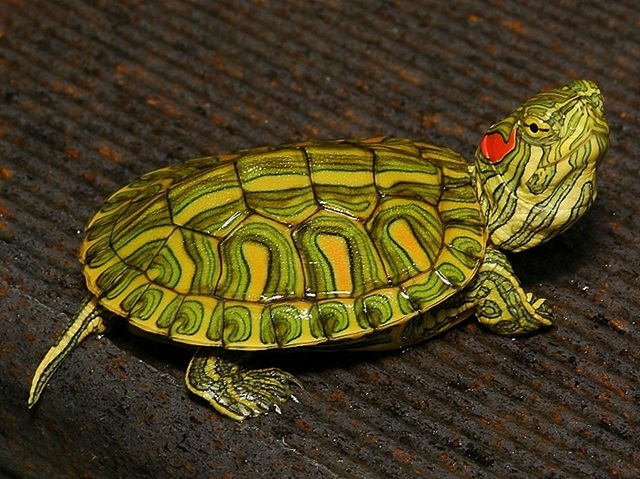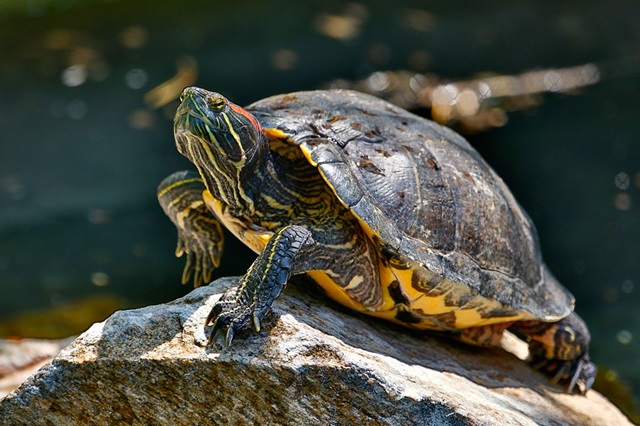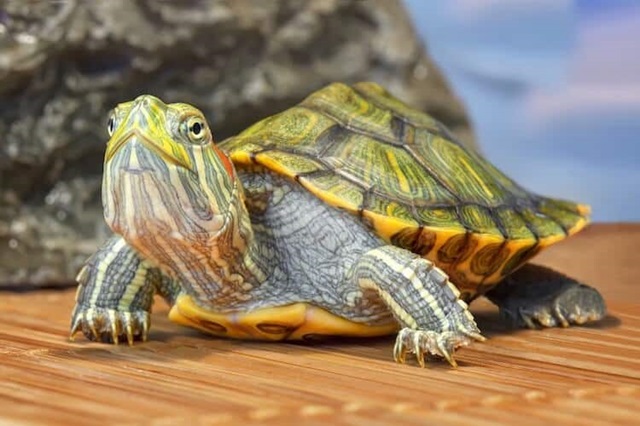Are you considering welcoming a red-eared slider into your home? These charming turtles, known scientifically as Trachemys scripta elegans, are popular pets thanks to their striking appearance and curious nature. However, caring for a red-eared slider goes beyond just providing a tank; it requires a commitment to understanding their specific needs for habitat, diet, and health. In this comprehensive guide, Pet’s World covers everything you need to know to ensure your new shelled companion thrives, from setting up the perfect environment to recognizing health problems . general health. Join us as we delve into the world of red-eared sliders and discover how to care for them as best as possible.

Introduction to Trachemys scripta elegans (Red-Eared Slider)
The red-eared slider (scientific name: Trachemys scripta elegans) is one of the most popular pet turtles in the world. Known for the distinctive red marks behind their eyes, these turtles are loved by beginners and experienced reptile owners alike. With their curious behavior and striking appearance, red-eared sliders can be a delightful addition to your home.
However, keeping a red-eared slider isn’t as simple as putting it in a tank with some water. These turtles require specific care, habitat conditions, and attention to thrive in captivity. In this guide, we’ll dive into everything you need to know about caring for a red-eared slider, from setting up the perfect habitat to understanding their dietary needs and behavior.
Red-Eared Slider Care Requirements
Ideal Habitat Setup for Red-Eared Sliders
Creating a suitable environment for your red-eared slider is crucial for its health and well-being. Red-eared sliders are aquatic turtles, so they need a tank that provides both water for swimming and dry areas for basking.
Tank Size and Environment
For adult red-eared sliders, a 75-gallon tank or larger is recommended. These turtles grow to around 12 inches in length, so giving them ample space to swim and explore is essential. A good rule of thumb is at least 10 gallons of water per inch of turtle shell.
The tank should be filled with water deep enough for the turtle to fully submerge and swim comfortably. Aim for a water depth of at least 12-18 inches, depending on the size of your turtle.

Water Quality and Filtration
Maintaining clean water is critical to preventing health issues like shell rot and respiratory infections. A strong filter, such as a canister filter, is highly recommended. Regular water changes, at least 25% weekly, will help keep the environment healthy.
Basking Areas and Temperature Control
Red-eared sliders are cold-blooded reptiles and need a basking area where they can dry off and regulate their body temperature. Provide a basking platform that is completely out of the water, with a heat lamp positioned above. The temperature of the basking area should be between 85-90°F, while the water temperature should be maintained at 75-80°F for adults and slightly warmer for younger turtles.
A UVB light is also necessary to help your turtle produce vitamin D3, which is essential for calcium absorption and preventing metabolic bone disease.
Feeding Your Red-Eared Slider
Red-eared sliders are omnivores, meaning they eat both plants and animal matter. Their diet should be varied to ensure they receive all the nutrients they need to stay healthy.
Types of Food
A red-eared slider’s diet should consist of commercial turtle pellets, live or frozen prey like crickets or mealworms, and a variety of fresh vegetables. Leafy greens like kale, collard greens, and dandelion leaves are excellent choices. You can also offer them aquatic plants like duckweed.
Feeding Schedule
Young turtles (under 1 year old) should be fed every day, while adult turtles can be fed every 2-3 days. Ensure that they are given a portion of food that they can eat in about 10-15 minutes. Overfeeding can lead to obesity and health issues, so it’s important to monitor their food intake.
Supplements and Vitamins
In addition to their regular diet, you may want to provide calcium supplements to ensure your turtle’s shell and bones stay strong. Calcium can be given in the form of a cuttlefish bone or a powdered supplement sprinkled over their food.

Common Health Issues in Red-Eared Sliders
Like any pet, red-eared sliders are prone to certain health problems, especially if their living conditions aren’t optimal. Being aware of potential issues can help you take preventative measures and seek timely treatment.
Shell Rot and Respiratory Infections
Poor water quality and improper basking conditions can lead to shell rot, a bacterial or fungal infection that causes the turtle’s shell to become soft or develop lesions. Ensure that your turtle has a dry, warm basking area and that the tank is cleaned regularly.
Respiratory infections are another common problem, especially in turtles kept in water that is too cold. If you notice your turtle wheezing, sneezing, or having difficulty breathing, it’s time to visit a reptile vet.
Preventative Care and Regular Vet Visits
To keep your red-eared slider in the best health, ensure they have a clean tank, proper lighting, and a well-balanced diet. Regular vet check-ups, especially if you notice any signs of illness, can help catch problems early and keep your pet happy and healthy.

Red-Eared Slider Behavior and Interaction
Red-eared sliders are fascinating to observe. While they aren’t as interactive as some pets, they do exhibit a range of behaviors that can indicate their comfort and well-being.
Natural Behaviors in Captivity
Red-eared sliders spend a lot of time swimming, basking, and foraging for food. If your turtle is active, moving between the water and basking platform regularly, that’s a good sign. However, if they are lethargic or refuse to bask, it may indicate a problem with their environment or health.
Handling and Interaction
Although red-eared sliders can tolerate being handled, it’s important to minimize handling as it can cause them stress. When handling them, make sure to support their body fully and avoid flipping them over or allowing them to drop. Regular interaction can help your turtle become accustomed to your presence, but always be mindful of their comfort level.
Legal Aspects of Keeping Red-Eared Sliders
Before adopting a red-eared slider, it’s important to know the legal regulations surrounding their ownership. Due to their invasive nature, red-eared sliders are restricted or banned in some states and countries. Be sure to check your local laws to ensure that you can legally own one.
In the U.S., red-eared sliders under 4 inches in size cannot be sold as pets due to health concerns (specifically salmonella transmission). Additionally, releasing pet turtles into the wild is highly discouraged, as they can disrupt local ecosystems and outcompete native species.

Best Practices for Maintaining a Healthy Turtle Tank
Keeping your turtle’s environment clean and well-maintained is one of the most important parts of caring for a red-eared slider.
Importance of Filtration and Water Changes
A powerful filter is essential for maintaining water quality in a turtle tank. In addition to filtration, perform partial water changes weekly to remove waste and toxins. This will help reduce the risk of diseases and keep your turtle happy.
Cleaning and Maintenance
Every 2-4 weeks, the tank should be cleaned thoroughly. This includes scrubbing algae from the walls, cleaning decorations, and replacing the water. Avoid using harsh chemicals when cleaning; instead, opt for turtle-safe cleaners.
Optimal Lighting and Heating Setups
Ensure that your tank is equipped with both a heat lamp for basking and a UVB light for calcium absorption. These lights should be on for about 10-12 hours a day to simulate natural day/night cycles.

Conclusion and Final Tips for Red-Eared Slider Care
Caring for a red-eared slider can be a rewarding experience, but it requires a commitment to providing the right habitat, diet, and care. With the right setup, your turtle can live a long and healthy life, often reaching 20-30 years in captivity. By understanding their needs and being proactive about their care, you can enjoy years of companionship with your shelled friend.
Frequently Asked Questions
- What is the best diet for red-eared sliders?
Red-eared sliders should be fed a balanced diet that includes commercial turtle pellets, leafy greens, and occasional live prey like crickets. - How long do red-eared sliders live in captivity?
With proper care, red-eared sliders can live between 20-30 years in captivity. - Are red-eared sliders legal to keep as pets in all states?
No, red-eared sliders are restricted or banned in some states due to their invasive nature. Be sure to check local regulations before adopting one. - What kind of tank setup does a red-eared slider need?
A red-eared slider requires a tank of at least 75 gallons, with both swimming space and a dry basking area.

